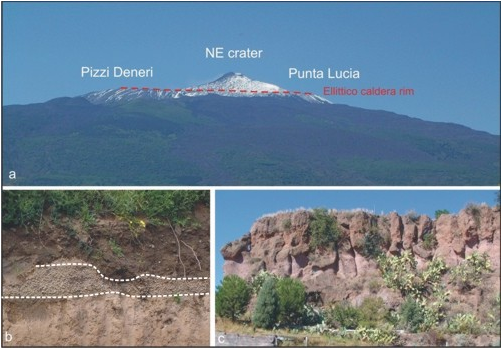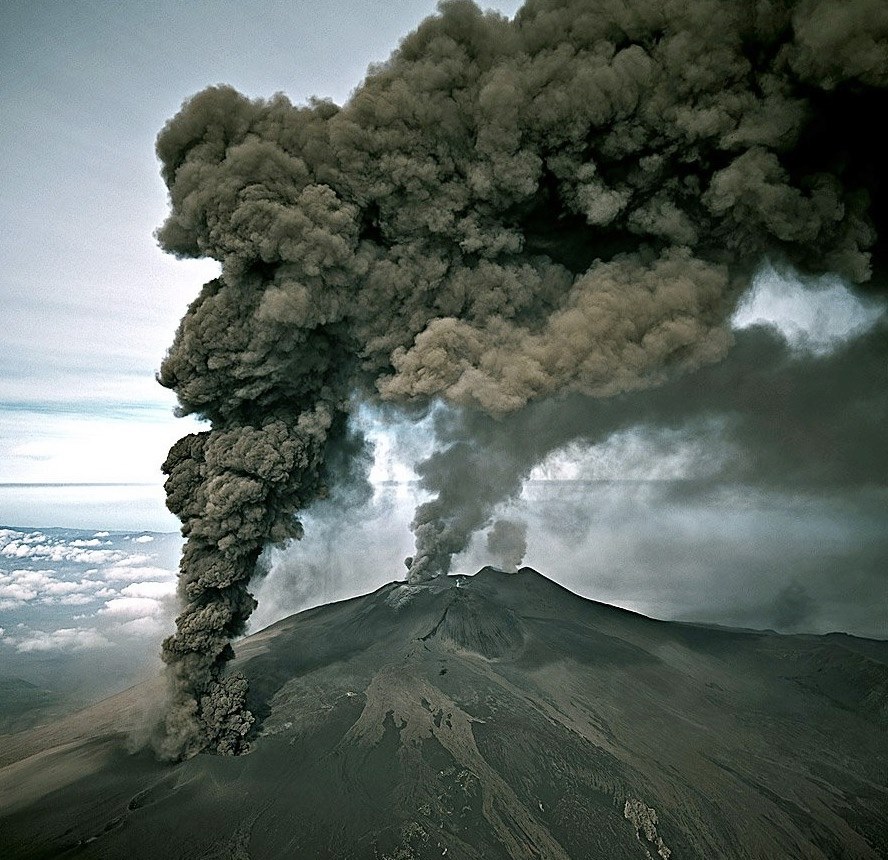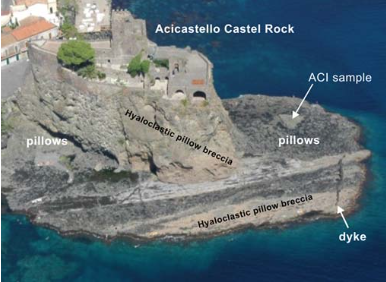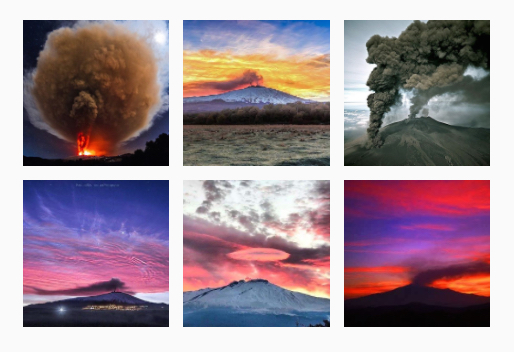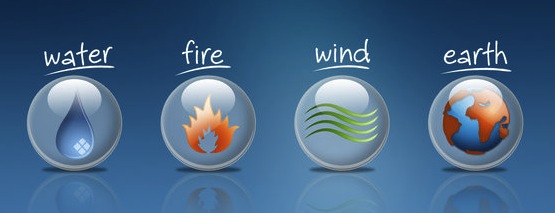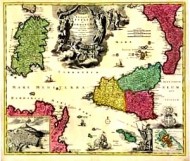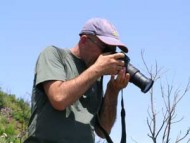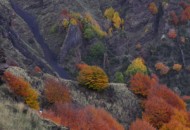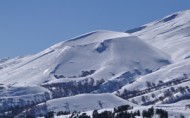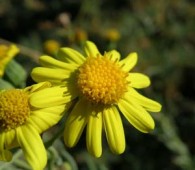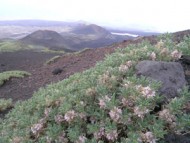Volcanology
This post is also available in: ItalianoEspañol
Volcanology of Etna
Etna is a magnificent volcano and an irresistible attraction for nature lovers. It is the highest volcano of continental Europe, the highest mountain of the mediterranean basin and one of the most active volcanoes in the all world. It is a multiple stratovolcano and its present morphology is the result of the growth of several edifices fed by different eruptive axes. At the summit it has four craters with an almost persistent activity and about 300 craters all around it, a sort of cooperative of little monogenetic volcanoes. Its geomorphology is of a shield volcano, on top of which grew a younger stratovolcano. It has about 250 lava tubes, several large calderas and it lies at a crossroad of fault lines, between two different tectonic plates in a compressive tectonic setting. Mt.Etna has effusive and explosive activity and is able to display an impressive variety of eruptive styles, from hawaiian to strombolian, from volcanian to sub-plinian etc. When the volcanic activity is particularly intense, in one year this volcano may eject a volume of volcanic products comparable to the volume of a 100 story skyscraper! The length of one eruption is ranging from less than an hour to months or years in a row. Other possible variations are the intensity of the eruptions (from weak to very strong ones), the volume of lava emitted and the location where the eruption starts (either from one of the craters of the summit or from a brand new lateral crater). Etna has also the world’s longest documented records of historical volcanic activity, dating back from about 3000 years ago.
Volcanological evolution
The volcano that we see today is the result of a very extended evolution that lasted about 600.000 years that it is usually divided in four phases:
First phase Basal Tholeiites from 600.000 to 220.000 years ago
About half million year ago, in the area that nowdays is occupied by this massive volcano, there was a large bay, the so called Pre-etnean gulf, that stretched from the Peloritani and Nebrodi mountains (the Euroasian plate) all the way to the south to the Hyblean plateau (the African plate). That’s where the long volcanological adventure of this volcano started with scattered submarine fissure-type volcanism that in time probably built some small volcanic islands. The volcanic rocks that belong to this fase are tholeiitic basalts, subalkaline rocks that occur in a wide variety of tectonic settings (hot spots such as Hawaii or mid-ocean ridges). These rocks are formed from 20% to 30% melting of the mantle at a depth from 40 to 70 km.
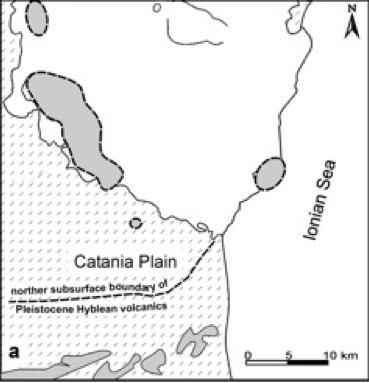 North of Catania there is a outstanding geosite in the area of Acicastello where there is an outcrop of pillow-lava (typical of subaqueous eruptions) and a hyaloclastic pillow-breccia. North of Acicastello the geosite continues in Acitrezza where is possible to find some columnar basalts. More recent outcrops (about 300.000 years old) of subaerial Tholeiites are found close to Adrano, Paternò and Biancavilla. This was the longest phase in the evolution of Etna despite the relative small volume of the volcanic products.
North of Catania there is a outstanding geosite in the area of Acicastello where there is an outcrop of pillow-lava (typical of subaqueous eruptions) and a hyaloclastic pillow-breccia. North of Acicastello the geosite continues in Acitrezza where is possible to find some columnar basalts. More recent outcrops (about 300.000 years old) of subaerial Tholeiites are found close to Adrano, Paternò and Biancavilla. This was the longest phase in the evolution of Etna despite the relative small volume of the volcanic products.
Second phase the Timpe from 220.000 years ago to 110.000 years ago
The second phase took place in a small area that runs parallel to the Ionian coast where there is a distensive fault system known as Timpa that represent the northern prosecution of a fault line that from Malta crosses the Hyblean Plateau manteining a NNW-SSE direction. Along this axis some fissural eruptions took place that formed a shield volcano with an elliptical base of about 20 km.  From the first to second phase the products changed from from sub-alkaline basalts to alkaline basalts and hawaiites. Lava rocks that belong to the Timpe phase are found at Paternò and in the area of Leucatia. Starting from about 130.000 years ago the eruptive fissural activity shifted westwards in an area between Moscarello and Val Calanna.
From the first to second phase the products changed from from sub-alkaline basalts to alkaline basalts and hawaiites. Lava rocks that belong to the Timpe phase are found at Paternò and in the area of Leucatia. Starting from about 130.000 years ago the eruptive fissural activity shifted westwards in an area between Moscarello and Val Calanna.
Third phase the Valle del Bove eruptive centers from 110.000 to 57.000 years ago
This phase is characterized by a further westward shift of the eruptive axis to the Valle del Bove. Perhaps the feeding system was defined by the intersection of NNW-SSE fault line system with the other main one alined NNE-SSW. Also from the fissural eruptions of the first and the second phase there was a change to a centralized explosive and effusive volcanic activity that progressively filled up with new formed rocks large area of the pre-etnean bay. 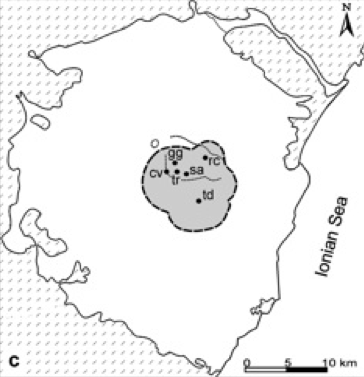 During this time the structure a big strato-volcano was built with the super-imposition of the products of different eruptive centers. The first ones were Tarderia, Rocche e Trifoglietto. The latter was the most elevated one, reaching the altitude of about 2500 m. and about 100.000 years ago ended its eruptive cycle with a Plinian eruption. New eruptive centers grew around the ruins of the older ones, Mt.Cerasa, Giannicola, Salifizio e Cuvigghiuni. The volcanic rocks that belong to this phase have usually a hawaaiitic to mugearitic composition, but there were also rocks of trachyandesitic composition and for this reason the resulting volcanism was much more explosive.
During this time the structure a big strato-volcano was built with the super-imposition of the products of different eruptive centers. The first ones were Tarderia, Rocche e Trifoglietto. The latter was the most elevated one, reaching the altitude of about 2500 m. and about 100.000 years ago ended its eruptive cycle with a Plinian eruption. New eruptive centers grew around the ruins of the older ones, Mt.Cerasa, Giannicola, Salifizio e Cuvigghiuni. The volcanic rocks that belong to this phase have usually a hawaaiitic to mugearitic composition, but there were also rocks of trachyandesitic composition and for this reason the resulting volcanism was much more explosive.
Forth phase the Stratovolcano from 57.000 years ago to present days
A further movement of the eruptive axis caused the end of the previous stage of the evolution of Etna and the beginning of a new phase in which a new volcano, that we call Ellittico, started a new powerful explosive and effusive activity that pushed up the altitude of Etna getting perhaps to about 3800 m, more than 400 meters higher than today. Big lava flows went down the slopes of this new volcano (reaching the Alcantara river to the North and the Simeto river to the South) and the numerous explosive eruptions accumulated big layers of pyroclastic material. During this phase there were the most acidic product of the entire history of Mt.Etna, the trachytes. The Ellittico ended his tage about 15.000 years ago with one or most powerful Plinian eruptions that made the old summit to disappear and formed a large caldera about 4 km across that after this event was going to be slowly filled up by the products of following eruptions. We call Mongibello the volcano that grew on the ruins of Ellittico, the same volcano that continues its activity today. During this phase the effusive activity prevails and happens from the summit craters and along few areas of weakness, the South, the Northeast and the West rifts. There is always also the explosive component that in some events has also reached a quite high intensity.
